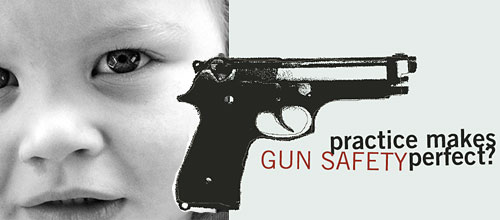
Gun safety practice makes perfect?
Molly* is tiny for a six year old. She has enormous blue eyes and mussed blond hair that falls just to the hood of her sweatshirt. She fidgets a little with the pocket, but when an adult whispers reminders in her ear, she nods confidently, and is ready to get to work.
Her job is to teach a still younger girl what to do when she sees a gun.
In this practice session, the teacher - little Molly - places a very real looking gun near some art supplies, and then later asks her student to get a box of crayons. Her charge heads for that part of the room but abruptly dashes out. She is practicing the important skills of not touching a gun and running from the gun to report its presence to an adult.
The student succeeds in five of five scenarios, earning not only kind praise from the adult, in this case graduate student Candice Jostad, but also another smiley face for her worksheet. A full course of these stickers, she knows, will earn her a treat bag.
Molly is an experienced trainer. "Good job, you earned a smiley face," she recites to her student with each successful run from the gun. Neither the teacher nor the student find it amazing - at ages that add up to only 10 - to be doing such important learning.
This scene is part of an ongoing project in the psychology department at North Dakota State University led by Ray Miltenberger, who has spent most of his career working out ways to teach people to avoid dangers. He's studied other prevention situations, like what works in teaching developmentally disabled people avoid sexual abuse, and how to teach children to resist abduction attempts.
When he came upon a television news program about children playing with guns, he knew he had another topic.
"My position is not pro- or anti-gun," Miltenberger says. "Guns are out there. Parents and kids need to learn safety."
So far, Miltenberger's group has proven his initial expectation, that kids can learn to say that they shouldn't touch a gun, but they need to practice to be able to not touch a gun. The researchers have experimented with various combinations of teaching, practicing and testing, adult versus child teachers, multiples of practice, frequency of sessions, locations of lessons.
Miltenberger wants to find the formula that ensures the kids will "ptwewh, zzzzzting outta that room and yell 'there's a gun.' "
Practice, practice, practice.
The study is evaluating a procedure in psychology called behavioral skills training. It's a straightforward concept. As Miltenberger says: Would you want an operation from a surgeon who has only read a book on the subject? Would you expect a basketball team to just talk about good defense? Would our military succeed if training consisted only of reading and repeating strategies?
Once Miltenberger gets started on analogies, the examples flow quickly.
Picture yourself behind the wheel of your car, buzzing along nicely, and then you hit a little patch of ice. Do you think to yourself "The proper procedure when the rear of your vehicle begins to fishtail is to turn the wheel toward the spin," and then slowly, deliberately, perform based on the words you memorized from the manual? You'd be in the ditch long before you had time to think. The thing is, you've had enough practice to just do it.
This idea - being able to react as you need to because you've practiced - is the basis of behavioral skills training. "You've got to do it, and in a simulated situation so it's like what you really experience," Miltenberger says.
Two studies of existing programs, which were using the first two elements of behavioral skills training - instruction and modeling - found that kids "just can't say no" to touching guns. Miltenberger's study is finding that the next two parts - rehearsal and practice - must be added. "You need all four to get behavior to change," Miltenberger says. "Practice, practice, practice."
In the case of gun safety, this idea goes a step further than the regimen suggested by the National Rifle Association, through its Eddie Eagle GunSafe Program, which uses only the first two steps: it tells kids to stop, don't touch, leave the area, find an adult and shows the steps through coloring books and cartoons.
Miltenberger's behavioral skills training research has attracted a bit of media attention, including a Web piece by the news service Reuters, an article in the New York Times by columnist Jane Brody and an article in the May 2004 issue of Parenting Magazine, "Straight Talk About Guns." That article brought reaction from the NRA, which sent postcards to users of the Eddie Eagle program asking them to write letters to Parenting Magazine in support for the program. Although few letters were actually published in Parenting Magazine, the NRA's own publications continue to support the Eddie Eagle program and criticize the research that questions its effectiveness.
While plenty of others do take issue with Eddie Eagle, Miltenberger, as a scientist, says he's not out to criticize other programs. "The existing message is a good one, but without making them do it, they're not learning the skills. They're just learning to talk about it," he says. "With kids, we can't rely on talk to indicate action. One is not a good indication of the other."
-- Laura McDaniel

































